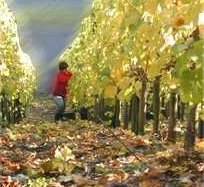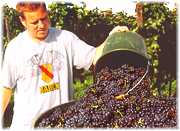| Introduction
| How Wine is made I
| How Wine is made II
| How Wine is made III |
| Climate and Quality
| Serving and Testing
| Wine and Food
|
II. HOW WINE IS MADE
Growing Grapes
Grapes grow on vines. There
are many different types of grapes, but the best wine grape is the European
Vitis vinifera. It is considered optimal because
it has the right balance of sugar and acid to create a good fermented wine
without the addition of sugar or water. It has been said that the wine
is only as good as the grape; a poor winemaker can ruin good grapes, but
a good winemaker isn't going to make great wine from inferior grapes.

Now before I say anything else about grapes, let me point out an error I have made in drafts of this document (and for all I know it may persist--proofreading is an art). That is the difference between "varieties" of grapes and "varietals." The word "varietal" means "of or pertaining to a variety." Types of grapes are "varieties." Wines made from a single variety are varietal wines. So, for example, a 100% Cabernet Sauvignon wine is a varietal. The cabernet sauvignon grape, zinfandel grape and merlot grape are varieties of grapes. (Of course, don't be confused that, for example, United States law allows a wine to be labeled Cabernet Sauvignon so long as it has at least 75% of that variety of grape. Now, is that clear?)
Vines start producing grapes about three years after planting; a useable crop after five years. They reach their prime in terms of crop yield between ages ten and thirty. Vines can grow for a hundred years, though production is reduced as they get older. However, reduced production (which is also caused in other ways--growing in poor soil, lack of irrigation, pruning the vines, climate, etc., the so-called "stressing the vines") can lead to "better" wine. So some very good wines come from "old vines."

Wine has been around for thousands of years, but in 1863, catastrophe struck. French vineyards were infested by Phylloxera.
Phylloxera is a louse that attacks the roots of the grape, causing the leaves to fall off and eventual death of the plant. The bug had come from America where the grapes were resistant to the creature. Phylloxera spread quickly through much of Europe and would have been completely devastating, except that a "cure" was found. It was possible to take Vitis vinifera and "graft" it to American rootstock. The American rootstock was not affected by phylloxera and the grafted grapes were the European variety.
German grapes grow well in soil rich in lime. Native American grapes don't (and the wine they make is derogatorily described as "earthy" or "foxy"). American grapes were resistant to Phylloxera, the german grapes were not. Why not create a "hybrid" that has the best qualities of both? (You could grow the grapes from the hybrid, and this is done is some parts of the world, however most the desired variety of European grape onto the hybrid rootstock.)
Unfortunately, it turned out that there were at least two types of Phylloxera, known as Biotype A and Biotype B. AxR #1 was resistant to the first, but not the second. Type B is now spreading like crazy throughout the state. While there are other rootstocks to chose from, many producers may not be able to withstand the cost of replanting and will close. (It takes five to seven years for new vines to produce grapes--too long to wait for many.)

Harvest
Weather is a major factor is determining whether a year is going to be a "good vintage" (or "year"). For example, was there enough heat during the growing season to lead to enough sugar? At harvest time, the short term effects of weather are quite important. To produce great wine, the fruit shouldbe ripe (but not overripe), and have a high (but not overly high) sugar content ("brix"; typically about a 22 brix for table wine). Think of raisins. As the fruit dries, the water evaporates. What is left is the sugary fruit. If it rains just at the point the wine grapes are ready, and before the grapes can be harvested, the additional water will cause the water level to increase, and the brix will go down. Not good. (You might ask, why not just add some sugar in the wine-making process? Some do. Also considered "not good.")
Every year the wine grape grower plays a game
of chance and must decide when to harvest. Simplistically, if you knew
it wasn't going to rain, you would just test the brix until it was just
right, then harvest. If you harvest too soon, you will probably end up
getting a wine too low in alcohol content (there won't have been enough
sugar to convert to alcohol). These wines will be "thin."
If you delay harvest, there may be too much sugar, which leads to too low
acid content.
 This also affects the taste (and the aging possibilities)
of the wine.
This also affects the taste (and the aging possibilities)
of the wine.
During the harvest of 1989 I was in theRhine/Mosel areas of Germany, where there was scattered rain. Winemakers in the area were not a happy bunch. As it turned out, this turned out to not be a great year "overall." But, it depends. In some areas not 20 miles away, rain was not a factor, in others it was. So you can't make a blanket statement that for all wines it was a poor year.